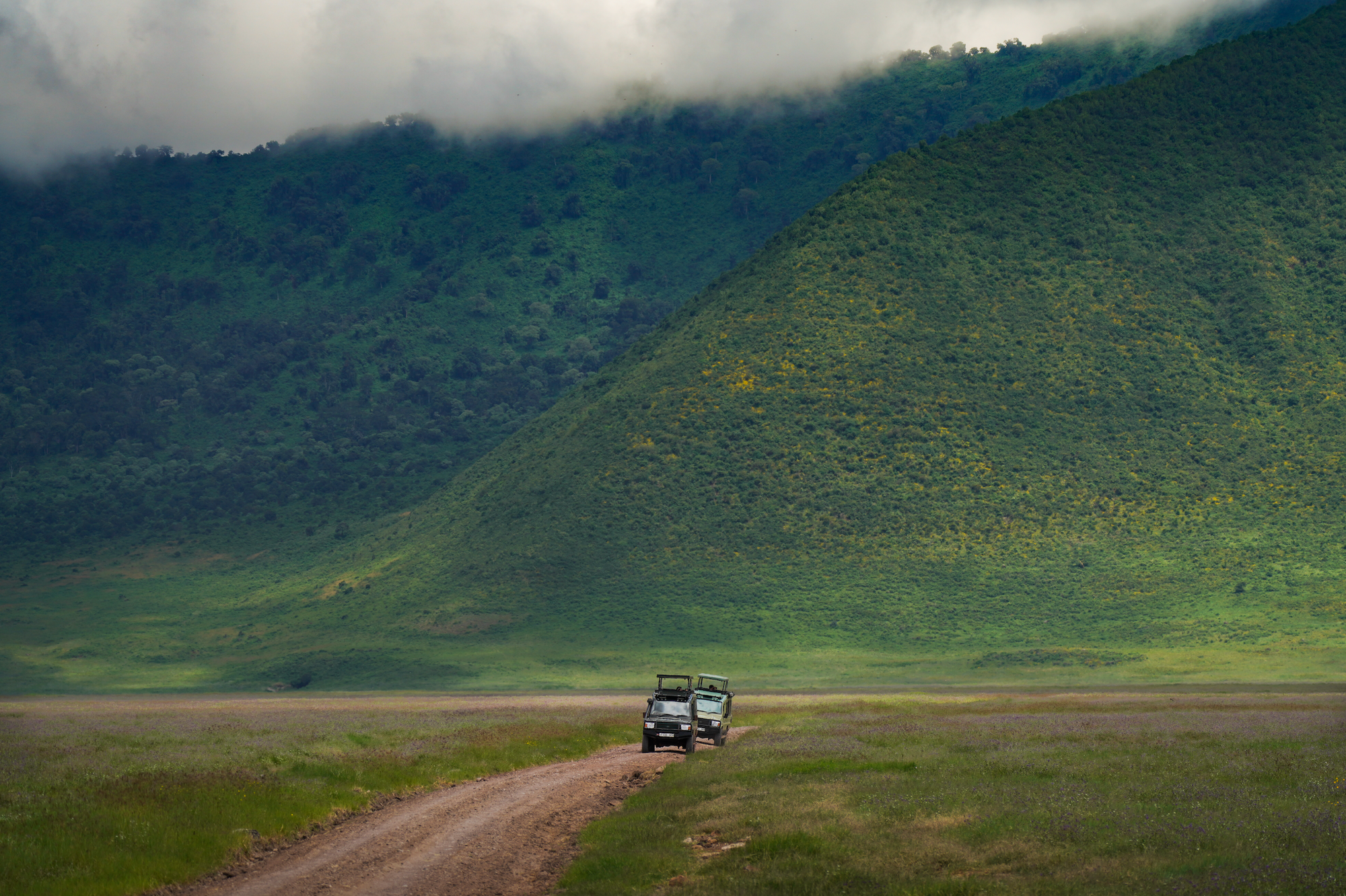Descending into the Ngorongoro Crater

Nestled within the eastern arc of the Great Rift Valley lies one of the world's most extraordinary natural wonders: the Ngorongoro Crater. Formed when a giant volcano exploded and collapsed on itself two to three million years ago, the crater now serves as a unique haven for wildlife, set against the backdrop of ancient calderas and lush highlands. Recognized as a UNESCO World Heritage Site, the Ngorongoro Crater offers a breathtaking blend of natural beauty, rich biodiversity, and a fascinating glimpse into the early human history. This blog takes you on a journey into the heart of the crater, exploring its wildlife and the awe-inspiring scenery that awaits those who venture down.
The Journey Down
Descending into the Ngorongoro Crater is like stepping into another world. The road winds through montane forests, with each turn revealing vistas more stunning than the last. As the forest canopy gives way, the vastness of the crater unfolds—a sprawling, 260 square kilometers (100 square miles) floor, surrounded by steep walls rising 600 meters (almost 2,000 feet) from the crater floor. The anticipation builds as the vehicle navigates the narrow path, each switchback offering a glimpse of the diverse habitats below, from open grasslands to patches of acacia woodland and shimmering lakes.
The Crater’s Unique Ecosystem
The Ngorongoro Crater's ecosystem is a marvel of the natural world, a self-contained environment with its own water sources and a near-perfect balance of predators and prey. The crater floor's varied landscapes, from the dense Lerai Forest to the soda lake of Lake Magadi, create niches for a wide array of species. The high walls of the caldera protect this ecosystem, creating a natural sanctuary for wildlife.
Wildlife of the Ngorongoro Crater
Big Five
The Ngorongoro Crater is one of the few places on earth where you can see the Big Five (elephant, lion, buffalo, leopard, and rhinoceros) in a single morning. The crater's elephants are mainly old bulls, their tusks long and curved. Lions prowl the open grasslands, while leopards, more elusive, are occasionally spotted in the Lerai Forest. The crater is also home to one of the highest densities of lions in the world. The buffalo roam in large herds, and the endangered black rhinoceros find refuge here, offering a rare opportunity for sightings.

Hyenas and Jackals
Hyenas are the crater's most common large carnivore, playing a crucial role in the ecosystem as scavengers. Jackals dart across the plains, ever opportunistic, contributing to the complex web of predator and prey.
Flamingos and Other Birdlife
Lake Magadi, a shallow alkaline lake, is often fringed with the pink of lesser flamingos, providing a stark contrast to the blue-green waters and the golden savannah. The crater is also a haven for birdwatchers, with over 200 recorded species, including birds of prey and the vibrant superb starling.
Wildebeest, Zebras, and Gazelles
The grasslands support herds of wildebeest, zebras, and gazelles, which in turn support a healthy population of predators. This dynamic interplay of grazers and hunters is a key aspect of the crater's ecological balance.

Endangered Species
The black rhinoceros of the Ngorongoro Crater is one of the most emblematic sights. Despite their dwindling numbers, the crater provides a sanctuary for these magnificent creatures, underscoring the importance of conservation efforts.
The Scenery and Landscapes
The Ngorongoro Crater's landscapes are as varied as they are stunning. From the panoramic views at the crater's rim, where the earth seems to stretch into eternity, to the intimate encounters on the crater floor, where each turn reveals a new wonder. The Lerai Forest, with its hauntingly beautiful fever trees, offers a cool retreat, while Lake Magadi shimmers under the African sun, a mirror reflecting the vast skies. The Ngoitokitok Springs, with their lush greenery, attract a variety of wildlife, providing excellent opportunities for close encounters.
Human History and the Maasai Culture
The Ngorongoro Crater and its surrounding highlands are not only an ecological treasure but also a repository of human history that dates back millions of years. The area stands as a testament to the coexistence of humans and wildlife, a relationship that has evolved over millennia and continues to shape the conservation practices and cultural landscapes of today.

The Maasai People: Guardians of the Land
Among the human inhabitants of the Ngorongoro Conservation Area, the Maasai people stand out for their storied history and sustainable living practices that have allowed them to live in harmony with the land and its animals. The Maasai are semi-nomadic pastoralists, whose lives are intricately linked to their livestock—cattle, sheep, and goats—which are considered a source of wealth and social status.
The Maasai's traditional knowledge of the environment and its cycles has enabled them to graze their animals in a way that minimizes environmental impact, preserving the biodiversity of the region. Their diet, culture, and economy are closely tied to their livestock, yet they have managed to maintain a balanced relationship with the wild animals that share their homeland. This coexistence is based on a deep respect for nature, with the Maasai holding certain species, such as lions, in high regard within their cultural beliefs and traditions.
Their distinctive red shukas (cloths), beadwork, and ceremonies add a rich cultural texture to the landscape of the Ngorongoro Crater. Visitors may have the opportunity to visit Maasai bomas (villages) to learn firsthand about their way of life, traditions, and how they have adapted to modern conservation needs while maintaining their cultural identity.
A Window into the Past: Archaeological Significance
The Ngorongoro Conservation Area is also of immense archaeological significance, with sites like Olduvai Gorge providing invaluable insight into early human evolution. Often referred to as the "Cradle of Mankind," Olduvai Gorge has yielded fossils and tools that trace back the story of human ancestry over millions of years. The discoveries made by Mary and Louis Leakey in the mid-20th century revolutionized our understanding of human evolution, revealing evidence of early hominids who inhabited the area.
Excavations at Olduvai and other sites within the conservation area have unearthed remains of Homo habilis, Homo erectus, and Homo sapiens, along with the tools they used, which illustrate a gradual increase in technological sophistication over time. These findings underscore the importance of the Ngorongoro area as a living museum, where each layer of soil reveals a chapter in the story of humanity.
Visiting the Ngorongoro Crater: Tips and Practical Information
The best times to visit the crater are during the dry seasons, from June to September and December to February, when wildlife viewing is at its peak. Conservation fees are used to support the preservation of this unique ecosystem, ensuring that the Ngorongoro Crater remains a source of wonder for generations to come.
Descending into the Ngorongoro Crater offers an unparalleled safari experience, where the majesty of the natural world is on full display. From the abundant wildlife to the breathtaking scenery, each moment in the crater is a reminder of the beauty and fragility of our planet. As we explore this extraordinary place, we are reminded of the importance of conservation and the role each of us plays in preserving these wonders for the future.
This journey through the Ngorongoro Crater reveals not only the diversity of wildlife and stunning landscapes but also the deep cultural connections to the land. Whether you're marveling at a pride of lions basking in the sun, watching flamingos dance along the lake's edge, or simply taking in the vastness of the crater from the rim, the Ngorongoro Crater offers an adventure that touches the heart and soul.
